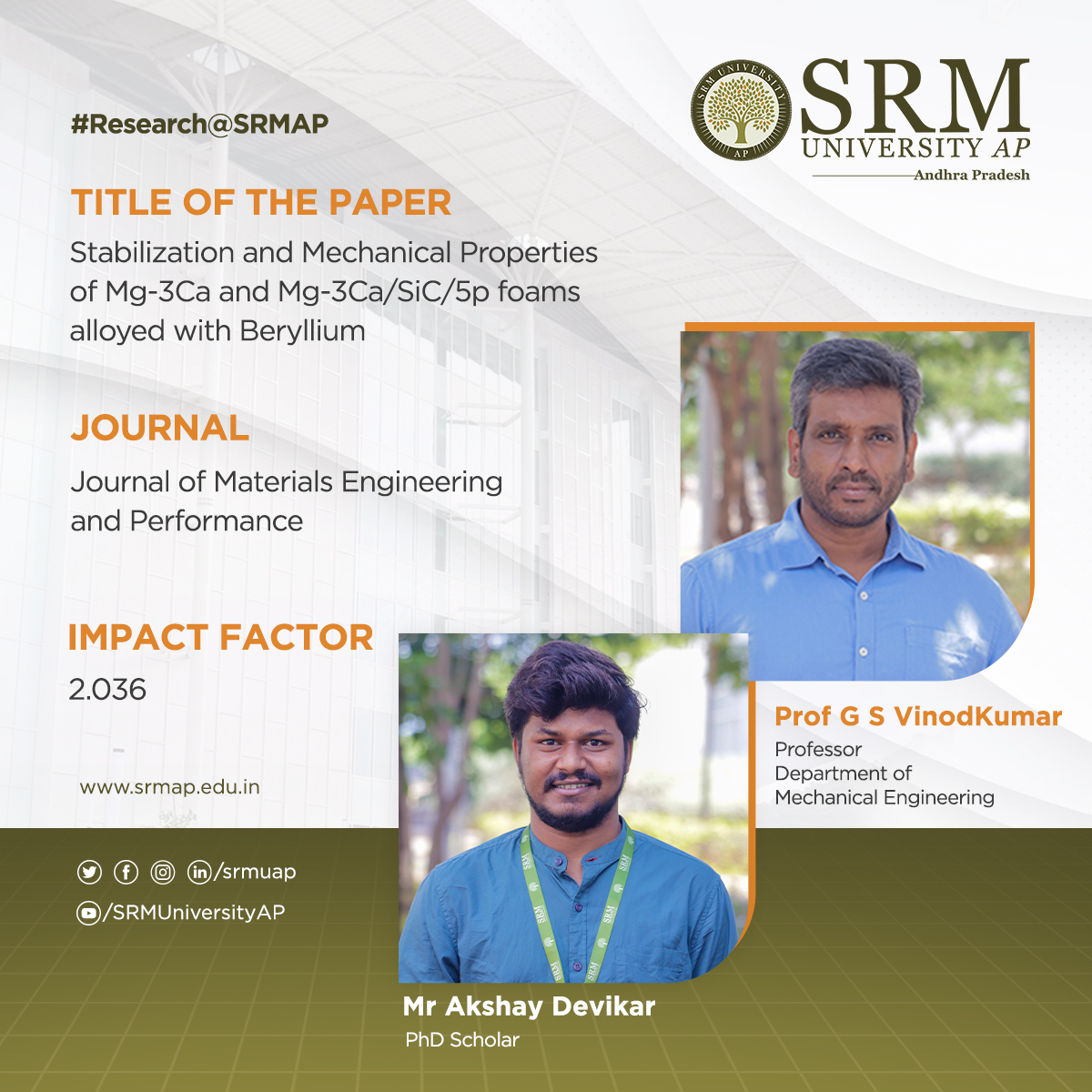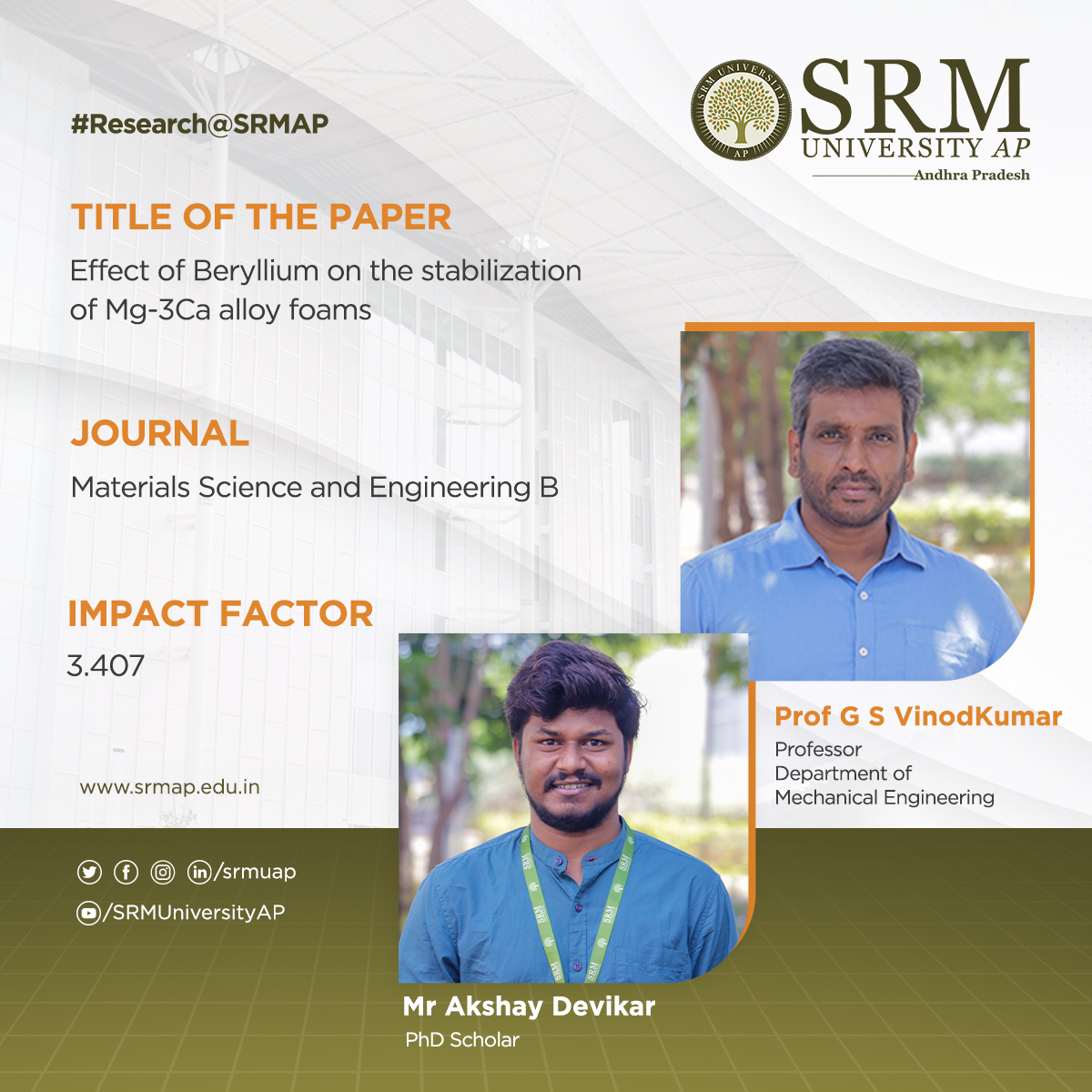A robust body of published works helps advance research capabilities and contribute to the larger research domain. Two latest paper publications from the Department of Mechanical Engineering are co-authored by Prof G S Vinod Kumar and his PhD student, Mr Akshay Devikar.
 The first paper, Stabilization and Mechanical Properties of Mg-3Ca and Mg-3Ca/SiC/5p foams alloyed with Beryllium, got published in the Journal of Materials Engineering and Performance and had an impact factor of 2.036.
The first paper, Stabilization and Mechanical Properties of Mg-3Ca and Mg-3Ca/SiC/5p foams alloyed with Beryllium, got published in the Journal of Materials Engineering and Performance and had an impact factor of 2.036.
Liquid processing of Magnesium is complicated due to its uncontrolled flammability in the presence of oxygen. However, owing to the lightweight property of Mg, it can be used as a structural material in various sectors such as naval, aerospace, automobile, biomedical, heat exchangers, and military applications. Therefore, using Ca and Be as alloying elements and oxidation preventers, the researchers produced lightweight Mg foams (of density 0.17 g/cm 3), which float on water. SiC particles provide excellent Mg foam stabilisation as well. The compression tests revealed the highest strength for Mg-3Ca foam containing both Be and SiC. Thus, the burning problem of Mg was overcome by adding Ca and a trace quantity of Be to make lightweight foams, which were strengthened by SiC particles.
Abstract
The present paper investigates the stabilisation of Mg-3Ca alloy and Mg-3Ca/SiC/5p composite foams with and without the addition of 0.12 wt.% beryllium. In Mg-3Ca alloy foam, Be addition has significantly improved the expansion and pore structure. Whereas, in the case of Mg-3Ca/SiC/5p composite foams, the SiC particles stabilised the foam effectively, while Be addition did not show any distinguishable improvement in the foam structure. The formation of BeO and the dense coverage of SiC particles in the gas-solid interface of Mg-3Ca and Mg-3Ca/SiC/5p composite foams, respectively, are the reasons for the foam stabilization. Mg-3Ca/SiC/5p composite foam exhibited the lowest foam density of 0.10 g/cm3. The quasi-static compression test shows that Mg-3Ca-0.12Be/SiC/5p composite foam containing Be exhibited lower foam density and higher normalized compressive strength. The energy absorption capacity per unit foam density in Be containing foams was also higher.
 The second paper, the Effect of Beryllium on the stabilization of Mg-3Ca alloy foams, is published in the journal Materials Science and Engineering B with an impact factor of 3.407.
The second paper, the Effect of Beryllium on the stabilization of Mg-3Ca alloy foams, is published in the journal Materials Science and Engineering B with an impact factor of 3.407.
Mg-3Ca alloy foams of density as low as 0.25 g/cm3 were successfully produced via the liquid metal route in an open-air atmosphere with trace Be addition. The stable BeO layer formed at the gas-solid interfaces of pores restricted the Mg + CO2/CO reaction, thereby reducing the gas loss responsible for foaming. Be addition (0.13 wt.%) resulted in a high-volume expansion of Mg-3Ca foam (694 %). Metallic single films also exhibited smooth and crack-free interfaces with Be addition.
Abstract
The present work is the first-ever study where the influence of beryllium (Be) addition on the stability of Mg alloy foam was investigated. Mg-3Ca alloy foams were produced by the liquid processing route with and without Be micro-addition. CaCO3 was used as a blowing agent. Mg-3Ca alloy foam without Be resulted in stable foam but exhibited low expansion with poor foam structure. Be addition significantly increased foam expansion and improved their structure. The expansion and the structure of the Mg foams obtained are comparable with that of commercially available aluminum foams. The XPS analysis confirmed the presence of BeO at the gas-solid interface of Mg foam. Be stabilizes the gas-solid interface of the foam by forming a smooth and crack-free surface of the BeO layer, which prevents the continuous oxidation of liquid foam and minimises the loss of blowing gas, thereby enhancing the stability of Mg-3Ca alloy foams.
Bulletproof vests, Car body parts, Hip and Knee implants, Sound and heat-proof walls in theatres, Naval ship bodies, etc., are some of the applications of the research findings. The researchers have collaborated with Dr Manas Mukherjee (Associate Professor) and his PhD student, Mr Biswaranjan Muduli of the Department of Metallurgical and Materials Engineering, Indian Institute of Technology Madras, Chennai, for this work. Stabilisation using other alloying elements and ceramic particles for improving mechanical properties of Mg foams specific to application requirements and establishing structure-property relationship from the point of view of melt viscosity by altering the foaming parameters are the future plans of the research team.

